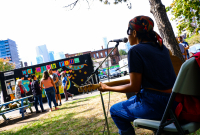Support strong Canadian climate journalism for 2025
This cheat sheet was prepared in anticipation of a Conversation event featuring Green party Leader Annamie Paul and Canada's National Observer editor-in-chief Linda Solomon Wood that will take place on Thursday, Nov. 12 at 7 p.m. ET/4 p.m. PT.
Green party leadership election and membership growth
- 35,000 Green party members were eligible to vote for new leadership after Elizabeth May’s resignation
- Nearly 24,000 cast votes
- This is 10 times the voter turnout for the party’s 2020 leadership election as compared with 2006
- In 2006, less than 3,300 members participated in the vote that elected May
- One in three of the party's members live in Ontario and one in four live in British Columbia
- Annamie Paul calls herself a "super fan" of May and credits her with exponential growth in the party
How did the Greens vote for their leader?
- A ranked-ballot voting system, which quickly redistributed members' second-choice votes if their first-choice candidate came last and was cut
- Paul took 12,090 votes on the last ballot, just more than the 11,939 needed to win
There are currently 3 Green MPs in federal parliament:
- Elizabeth May (Saanich-Gulf Islands)
- Paul Manly (Nanaimo-Ladysmith)
- Jenica Atwin (Fredericton)
Annamie Paul
- A non-practising lawyer
- Spent much of her career in international institutions, including at the International Criminal Court and in Canada's mission to the European Union
- The first Black and Jewish woman to lead a federal party in Canada
- Second person of colour, after Jagmeet Singh, to lead a federal party
- Second Jewish person, after NDP’s David Lewis in 1971
- Born in Canada to Caribbean immigrants (mother from Nevis, father from Dominica)
- Faced both racism and anti-Semitism during campaign, including during a virtual Green party town hall in July
- Founded the Canadian Centre for Political Leadership, an organization that focuses on helping “women, racial minorities and Aboriginal Peoples in pursuit of public office,” in 1996
- In the Toronto Centre byelection on Oct. 26, 2020, Paul did not win in her riding but received 33 per cent of the vote, coming in second to broadcaster Liberal Marci Ien, who took 42 per cent of vote in one of the "safest Liberal seats in the country"
- Paul calls her decision to run in the Toronto Centre byelection a “decision of the heart”
- On the loss of her father to an infection in a long-term care facility in May 2020:
“On the day that he died, my sister (actor Ngozi Paul) called me in tears and said to me, ‘We have got to do better than this, Annamie. We have got to know what a life is worth.’ So that is a question as we face down this pandemic, as we face down the climate emergency, that we must constantly ask ourselves, what is a life worth?” (As quoted in The Tyee)
Paul’s statements on diversity
“We all bring our lived experience, in addition to our professional experience and education, to our political lives. When you’re developing policy that particularly impacts communities, you’re far less likely to create public policy that has huge vacuums or gaping holes in it if the people who are going to be most affected by it are actually part of creating that policy.
“We have this very bad habit, unfortunately, in Canada for creating policies for communities where they have no participation in the process, and then consulting them about it retroactively. The only option they have is to comment on something that is already being done, supposedly, on their behalf.
“So by electing and having true diverse leadership from the very beginning of the process, we’re far less likely to have bad public policy. It’s an avoidable problem that we have in Canada, given how much diversity we have.”
On being a woman of colour in federal politics
“When you’re running as a woman of colour, with this level of politics, that is definitely what it takes. You have to be as near to perfect as you can be. And you have to be completely dedicated.”
On the pandemic and improving long-term care
“What we should have heard is a plan to sit down at the earliest possible moment with the provinces to talk about how we are going to create a truly national long-term care strategy and how we are going to begin to wrap long-term care into the Canada Health Act where it should have always been.”
On holding byelections in Toronto Centre during the second wave of COVID-19
“This is not the first time that low-income and racialised people have had to face barriers to their democratic participation. I ask the people of Canada to think of their neighbours, and ask themselves: would you accept voting in Stage II, under these circumstances, and before Elections Canada's proposed changes for a safe COVID election have been put in place? These are voting conditions that would be condemned in other countries.
“Toronto-Centre is a community that takes great pride in voting, and normally has a higher than average voter turnout. However, it is also a community in which 40% of residents do not have English or French as their mother tongue. Therefore, while sending out an Advance Voting notice, with 6 days to go to request a mail-in ballot, may be sufficient for some communities, it is certainly inadequate to secure the safe, accessible and democratic participation for the community of Toronto-Centre."
A few Green party policies highlighted on Paul's campaign site
Sixty per cent reduction in emissions by 2030 as compared to 2005 levels. The Green party has also committed to ensuring we reduce Canadian emissions in a way that is consistent with the global carbon budget remaining to avoid warming beyond 1.5 C. Canada can do this through a Green Recovery Plan that:
- Reinforces national carbon tax / rebate program
- Broader carbon adjustments
- Invests in renewable energy, large-scale green infrastructure, carbon capture technology
Guaranteed Livable Income (GLI)
"GLI would provide every Canadian with a basic revenue source, ensuring that people can cover basic expenses such as food and accommodation. It would be available with few or no restrictions and be sufficient to protect Canadians from the types of financial catastrophes that many find themselves confronting during the COVID-19 pandemic. Given that GLI would be comprehensive, it will also be simpler and therefore less expensive to administrate (usually one of the greatest costs of social programs)."
Reforming Canada’s police services
- Reduce: significant divestment in police services
- Reallocate: investing divested police services funds into community and social services
- Record: national database of police interactions with public
- Review: community oversight of police services
- Investing in completing effective networks of protected areas
- Committing to protecting 50 per cent of Canada’s natural landscapes by 2050, with an emphasis on biodiverse areas or areas with endangered species
- Investing in long-term protected area management, to maximize the benefits of, and return on, investment in protected areas that provide for local communities
- Developing a more ambitious Boreal Forest Protection Plan that will guarantee the conservation of endangered species, such as caribou, grizzly bears and wolverines
- Ensure that the Boreal Forest Protection Plan maximizes the storage capacity of the Boreal, which is over 300 billion tonnes of carbon (equal to 36 years’ worth of global emissions). Over the past 20 years, 25.4 million acres have been logged for industrial purposes. This number should be cut exponentially in the upcoming years
- Creating a protected zone in the Arctic in which no mineral resource exploration is permitted by any country






Comments